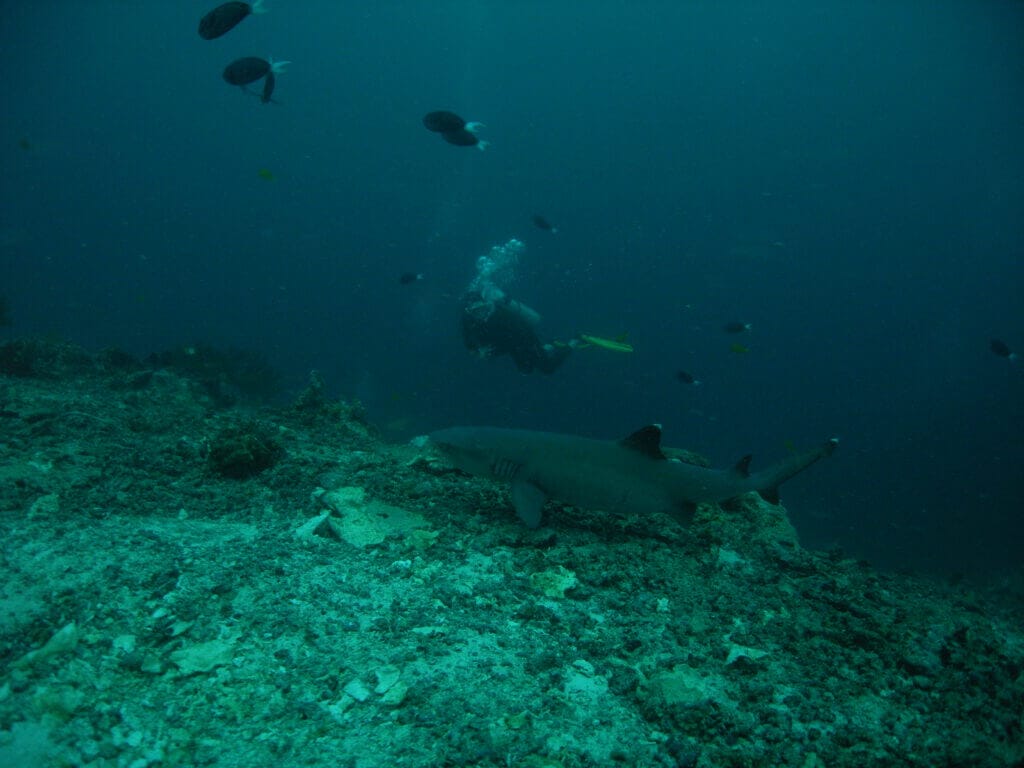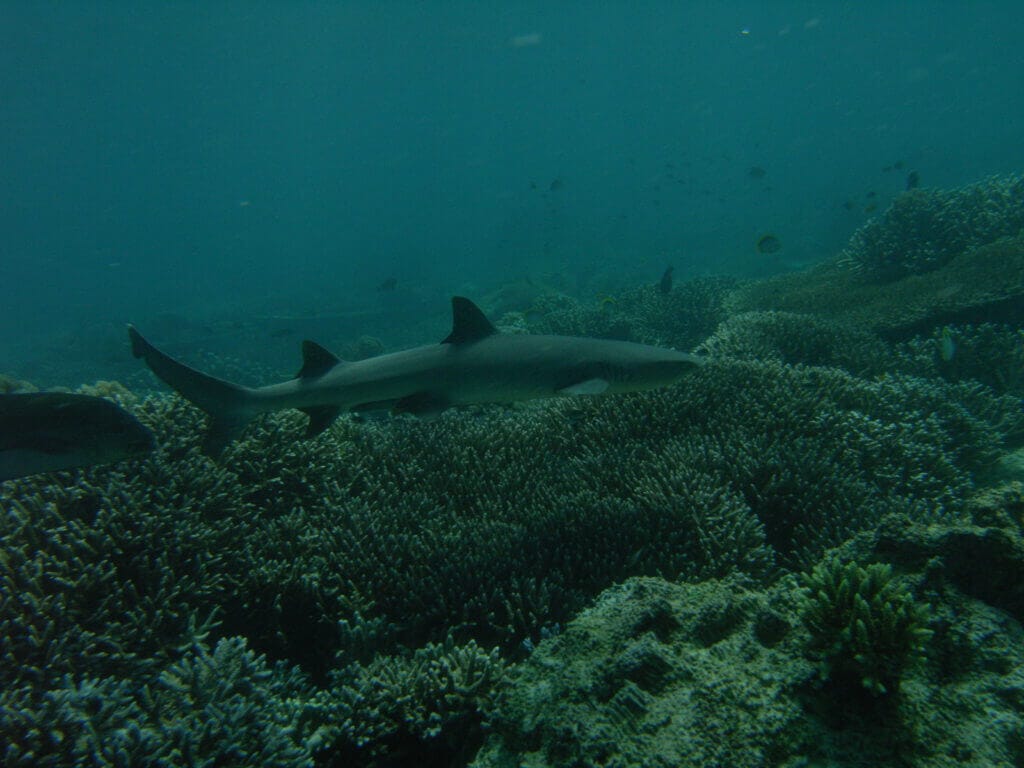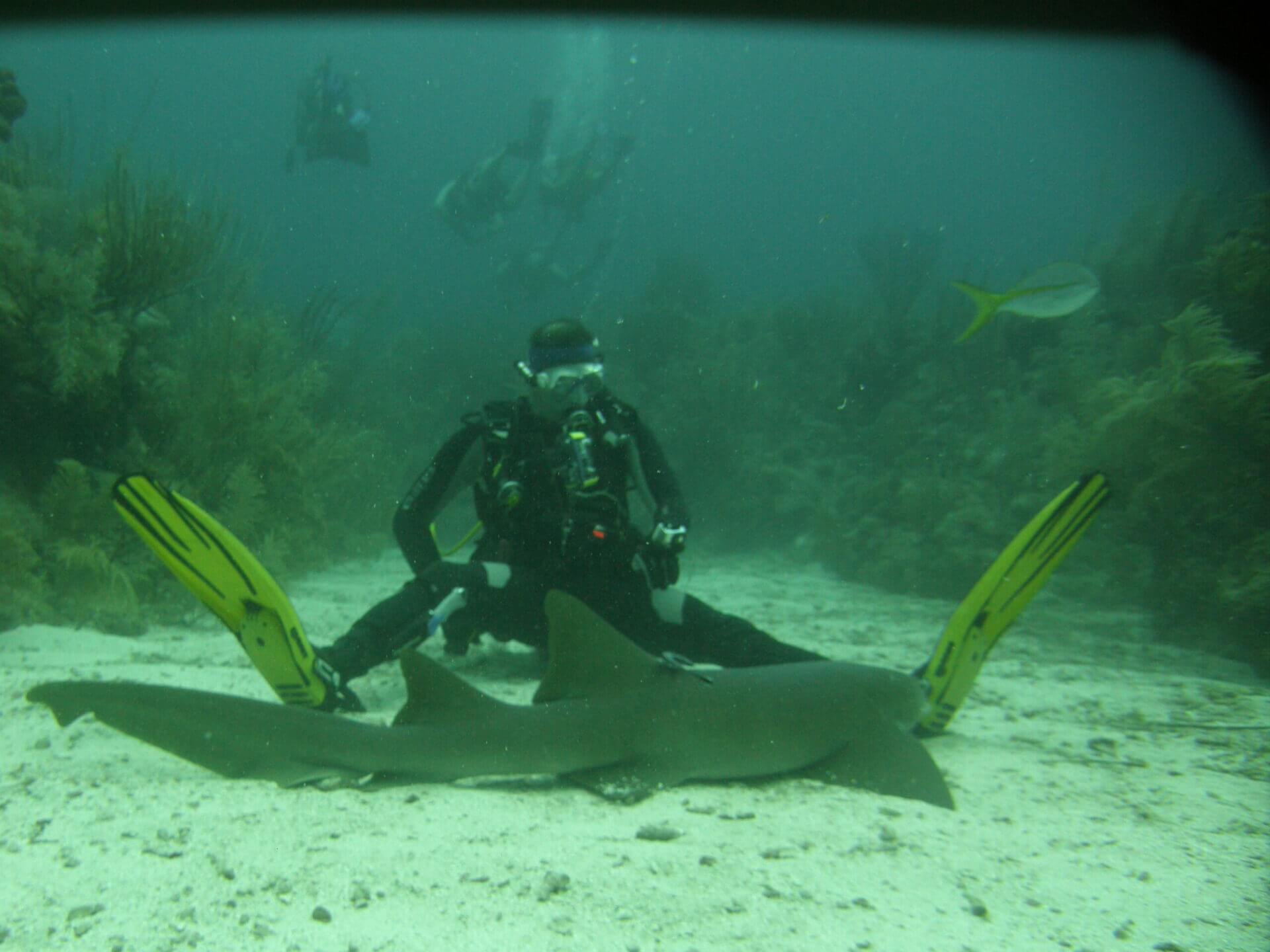I don’t know why people become divers but I think I stayed to see a shark underwater. Or is it because I was afraid to see a shark underwater? Divers have mixed feelings about sharks. Fascination and apprehension; challenge and thrill.
To begin with, we are all fed fears of sharks by the media. Starting with the movie “Jaws,” through reports under the title “Shark bites tourist.” Then when we learn to dive, more experienced divers talk about sharks as something interesting, something to see. Then we start diving and it turns out that we are the ones hunting the sharks (at least with the camera) and not them hunting us. However, some concern remains.
In order to learn to ride a horse well, you have to fall off a horse once. In order to stop fearing sharks, you have to meet a shark underwater for the first time.
When we start diving and go on our first trips to the reefs, sharks are always a topic of conversation. Some concern and curiosity. Will they or won’t they. One day we succeed. A shark arrives. A typical encounter looks like this: a group of divers swimming along the reef come across a shark “patrolling” around the reef. The shark notices the group of divers, accelerates slightly and with a graceful wide arc bypasses it, possibly posing for pictures for the more skilled photographers, and then disappears into the blue. His pulse quickened and he asked, “That’s it?” He didn’t lash out, didn’t bite, barely noticed us. Joy because he was beautiful and the thought that it was stupid to be afraid of sharks. After that, each subsequent encounter is an anticipated photo opportunity or an amazing experience. Moving underwater, a shark is the epitome of strength. Someone would say it is beautiful but it is not the beauty of a manta ray that is grace and agility. A shark is strength and agility, simply predator.

After a few encounters with sharks, we begin to get used to it although I guess some apprehension combined with fascination never passes. However, it is a powerful predator for which we are fortunately not the intended food.
Well, yes, but can we become food of chance?
Practice shows that except when, for example, shark baiting (more on that later) has changed their behavior; sharks do not show any aggression towards divers. They avoid us by a wide margin and, observing the group of divers and the shark from a distance, it is clear that it is the shark that has more respect than the divers. On top of that, most divers, especially photographers, at the sight of a shark throw themselves at it. No animal likes to have an encountered creature thrown in its direction so sharks in such a case definitely change their swimming path to avoid the “attacker”. I’ve experienced this many times while swimming with my camera for a shark, although there’s always the thought in the back of my mind of what will happen if it ever turns in my direction.
Where to look for sharks
Where is the easiest place to meet sharks? It depends on the species. Sand sharks or smaller reef sharks are often found “sleeping” at the base of the reef or in the crevices of the reef lying on the sand. Larger pieces patrol deeper areas usually where the current hits the deep base of the reef. A typical “shark dive” is to go out early in the morning, to the front of the reef from the current and descend 30-40 meters and then stare into the depths of the water. Sometimes a shark will come along. Places where there is a good chance of hitting sharks include Sipadan Island next to Borneo, Cocos Island next to Costa Rica and, of course, South Africa.

Shark baiting
If we are talking about sharks then we need to raise and think about the problem of shark baiting.
Divers want to see sharks, so dive organizers, sometimes try to attract them with food. After a while, the attracted sharks behave like dogs. Depending on the species like labradors or dobermans but nevertheless dogs. They arrive as the dive boat appears, swim up to the divers, and allow themselves to be photographed. However, such behavior has its dark side. First, we change the behavior of wild creatures. When this becomes widespread, it leads to changes in the entire ecosystem. This is not good for the animals that live there. The second problem is that the attracted sharks after a while associate dive boats and divers as a food source. They come close. And since they are predators, however, scared, curious or hungry, they may bite. Practice shows that in areas where sharks are attracted, there are more frequent incidents of shark attacks.
Cage diving with sharks
And finally, the issue of frames. The cages are a bit for divers and a bit for sharks. That is, of course, they are meant to protect divers but they are also meant to attract divers. Well, because if it’s a cage, it’s probably very dangerous and the beasts will come. We got chills and stories of how we were in the water with such dangerous creatures that we had to sit in a cage. It is impressive whether the cage is realistically needed or not. Certainly if sharks of large species are attracted then it is probably better to be in a cage. Where sharks manage to be observed in their natural habitat, cages are not needed, and incidents of attacks are much rarer than any other accidents that a diver may encounter.
Therefore, if cage diving itself is not particularly questionable, the already common luring of sharks into the vicinity of cages raises quite a few questions. Recreational divers or those who work underwater in the area – like seafood hunters – accuse baiting procedures of changing shark behavior, their excessive interest in boats and divers, and of causing shark attacks on humans to occur from time to time. Scientists are trying to study the extent to which luring sharks into the vicinity of cages affects their natural behavior. This certainly leads to the gathering of sharks in certain areas and their interest in boats. On the other hand, the opportunity to make money from diving with sharks leads to their greater protection in local communities.
Because of the sizable profits coming from cage dives, quite a few dive centers are choosing to run them. Depending on the season and the area of the world, such a dive can cost about 200- 400 euros.
Since cage diving is legal in the countries concerned, each of us has to answer whether we want to participate. Of course, the greatest desire is to dive with white sharks – powerful sharks that grow up to 6 meters and 3 tons. The best places to encounter white sharks are Isla Guadalupe (Mexico), Western Cape (South Africa), Farallon Islands (USA), Neptune Islands, (Australia).

Whale Shark
Whale sharks are the largest fish in the world and also beautiful underwater giants. They are harmless to humans. They feed similarly to some whales on plankton and often swim close to the surface of the water. Therefore, in many areas, whale sharks are a special “target” for diving and snorkeling expeditions. Unfortunately, since it is difficult to ensure their presence and there is little chance of a shark staying in one area for an extended period of time, they are often lured away by expedition organizers. Although the luring of whale sharks poses no potential danger to humans it does raise some questions due to the change in habits. On the other hand, the tourist attraction of whale sharks causes them to be protected in the local environment instead of being caught.
Shark conservation
Sharks are beautiful (their great usefulness to the environment is a separate matter) and they are still being caught, especially for the shark fin soup served in restaurants. Let’s try to protect sharks. First of all, let’s not order shark fin dishes, let’s not buy their jaws in bazaars, and let’s not screw up the industrial harvesting of sharks. It is we with our money as tourists who often influence the conduct and also the law in many countries. If we order shark fins in restaurants then sharks are caught. If you pay for dives where you can see sharks then the sharks are protected.












